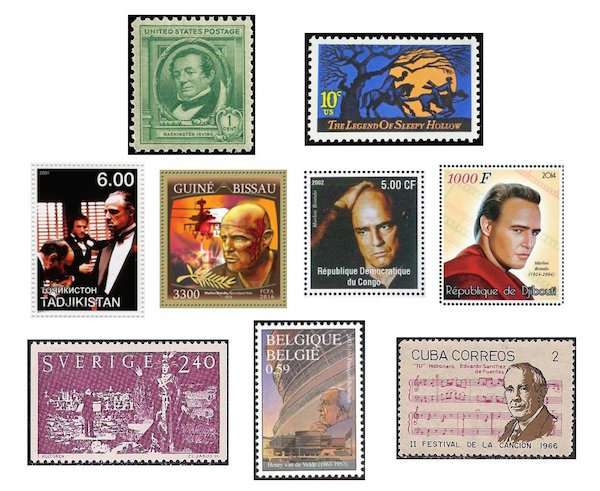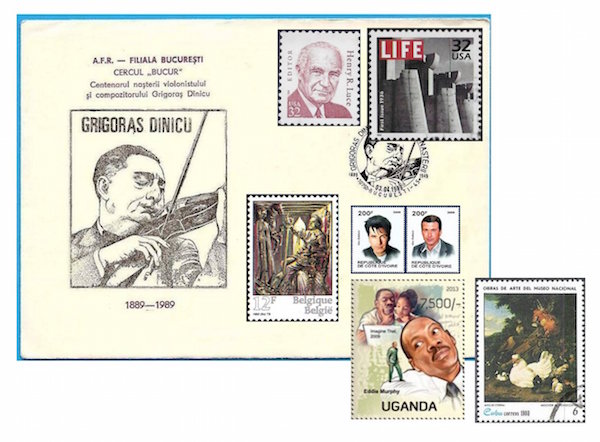The Arts on the Stamps of the World — April 3
An Arts Fuse regular feature: the arts on stamps of the world.

By Doug Briscoe
Today’s most elaborate birthday cakes go to Washington Irving and Marlon Brando, with half a dozen birthday cupcakes going out along with one funeral pie.
Washington Irving (April 3, 1783 – November 28, 1859) is celebrated on two stamps, the first from a big 1940 series honoring Americans in a variety of fields and the second a 1974 issue remembering his famous story “The Legend of Sleepy Hollow” (1820). Apart from that and the even more famous “Rip Van Winkle” (1819), Irving wrote much fiction, biographies of Oliver Goldsmith, Muhammad (!), and George Washington (for whom, of course, Irving was named and whom he had once met as a child), and histories of New York and of Spain, to which country Irving was American ambassador from 1842 to 1846. American sculptor Daniel Chester French, whose birthday is later this month (4/20) and who is also commemorated in that 1940 stamp series, created a Washington Irving Memorial in Irvington, New York in 1927.
Marlon Brando (April 3, 1924 – July 1, 2004), as the saying goes, needs no introduction. Just a few days ago, we honored James Caan, who appears in the background of this unofficial Godfather stamp (not valid for postage) from Tadjikistan. At first the choice of Apocalypse Now on the Bissau-Guinean and Congolese stamps struck me as odd until I considered the setting of Conrad’s magnificent short novel Heart of Darkness, upon which the movie is based. We leave it to Djibouti to provide us with a portrait of the young Brando. I think there’s little doubt that the United States will come out with a Marlon Brando stamp at some point.
Today is also the birthday of the excellent Swedish conductor Sixten Ehrling (3 April 1918 – 13 February 2005). A splendid conductor who left us a substantial recorded legacy, he was the first to record the complete Sibelius symphonies. He was at the helm of the Swedish Royal Opera from 1953 to 1960 and the Detroit Symphony from 1963 to 1973 and taught at Juilliard from ’73 to 1987. There Myung-Whun Chung, Jo Ann Falletta, Christian Badea, and Andrew Litton were among his pupils. This stamp, which also depicts soprano Birgit Nilsson (who happens also to have been born in 1918 and to have died in 2005!), is part of a set issued in 1981 to celebrate Swedish cultural and technological contributions (so not only is Ehrling not front-and-center, but you can barely see him—maybe, fingers crossed, both he and Nilsson will get centenary stamps next year). (Other stamps in that 1981 set show tennis player Bjorn Borg, skier Inge Stenmark, and various aspects of Swedish industry.)

Now we turn to a chronological listing of the “lesser lights”. Henry Clemens van de Velde (1863 – 25 October 1957) was a driving force behind Art Nouveau in Belgium, though the greater part of his architectural attention was focused on Germany. He turned away from his first love of painting around 1892 so as to work in interior design and soon branched out into architecture. His work was well received in Germany, and he relocated to Weimar in 1899, setting up a school of arts and crafts that would, after World War I, be supplanted by the Bauhaus. On the background of van de Velde’s stamp from 2003 is his Boekentoren (book tower), part of the Ghent University Library.
Eduardo Sánchez de Fuentes (3 April 1874 – 7 September 1944), besides being a composer, wrote books on Cuban folk music, but his work is seriously flawed in that he greatly underestimated the contribution of the Africans in Cuba. His most famous work is a habanera called “Tú”, which he wrote when he was only sixteen. His other works include an opera, Yumurí, a ballet, Dioné, and an oratorio, Navidad.
Grigoraș Dinicu was born on this date in Bucharest in 1889. His main claim to fame is the little virtuoso piece Hora staccato (1906), popularized by Heifetz. Dinicu studied with Carl Flesch and received a scholarship to attend the Vienna Conservatory, but was denied admittance because he was Romani. Both Heifetz and Stéphane Grappelli were great admirers of his playing. He died in his hometown on March 28, 1949 (some sources give August 5, 1948). Romania commemorated his centenary, not with a stamp, but with an envelope (what we philatelists call a “cover”).
Henry Luce (April 3, 1898 – February 28, 1967) founded the iconic American magazines Time (1923), Fortune (1930), and Sports Illustrated (1954), as well as having taken over and transformed Life magazine from 1936. He married Clare Boothe Luce in 1935, and the two of them were active in conservative politics for the rest of their lives. Now, I must relate a personal anecdote. A few years ago I visited the Cardinal Spellman Museum of Stamps & Postal History on the grounds of Regis College. In addition to the changing exhibits, the museum has some items for sale and periodically plays host to dealers to sell their wares. I saw a huge box of used stamps, sifted through it, and bought it, anticipating hours of philatelic sorting pleasure. (I was not disappointed.) All of the stamps had been carefully torn from the corners of envelopes, and on a few of them enough of the address remained to see that these cards and letters had all been sent to Mrs. Henry Luce III (Henry Luce’s daughter-in-law)! This story brought to you by the Brush With Greatness Dept.

Belgian playwright Michel de Ghelderode (1898 – April 1, 1962) wrote 60 plays before 1939, when he gave up the habit. An exponent of Expressionism and Symbolism, he tended toward eerily atmospheric if not explicitly supernatural settings and subjects. In addition to authoring a hundred short stories and various articles, Ghelderode was one of those prolific letter writers, having left some 20,000 of them. I had a hard time tracking down the significance of the image on the stamp, which depicts a carving, The King On His Throne; eventually it became clear (?) that this must be a reference to Ghelderode’s 1927 play Escurial, first produced in 1929. It tells the story of a mad king whose throne is usurped by his fool.
And happy birthday to two highly gifted performers: Alec Baldwin (born 1958), who has a pair of stamps from Côte d’Ivoire (go figure!), and Eddie Murphy (born 1961), whose stamp comes from an Ugandan sheet celebrating African-American celebrities.
On this day in 1695 Dutch animalier Melchior d’Hondecoeter (born c. 1636) died. Son and grandson of painters, his output is concentrated mostly on avian paintings. One of his characteristic works, Domestic Fowl, is seen on a 1980 Cuban stamp highlighting works that hang in that country’s National Museum.
Alas no stamp for the great religious Jacobean poet George Herbert (3 April 1593 – 1 March 1633).
A graduate of the University of Massachusetts with a B.A. in English, Doug Briscoe worked in Boston classical music radio, at WCRB, WGBH, and WBUR, for about 25 years, beginning in 1977. He has the curious distinction of having succeeded Robert J. Lurtsema twice, first as host of WGBH’s weekday morning classical music program in 1993, then as host of the weekend program when Robert J.’s health failed in 2000. Doug also wrote liner notes for several of the late Gunther Schuller’s GM Recordings releases as well as program notes for the Boston Classical Orchestra. For the past few years he’s been posting a Facebook “blog” of classical music on stamps of the world, which has now been expanded to encompass all the arts for The Arts Fuse.
